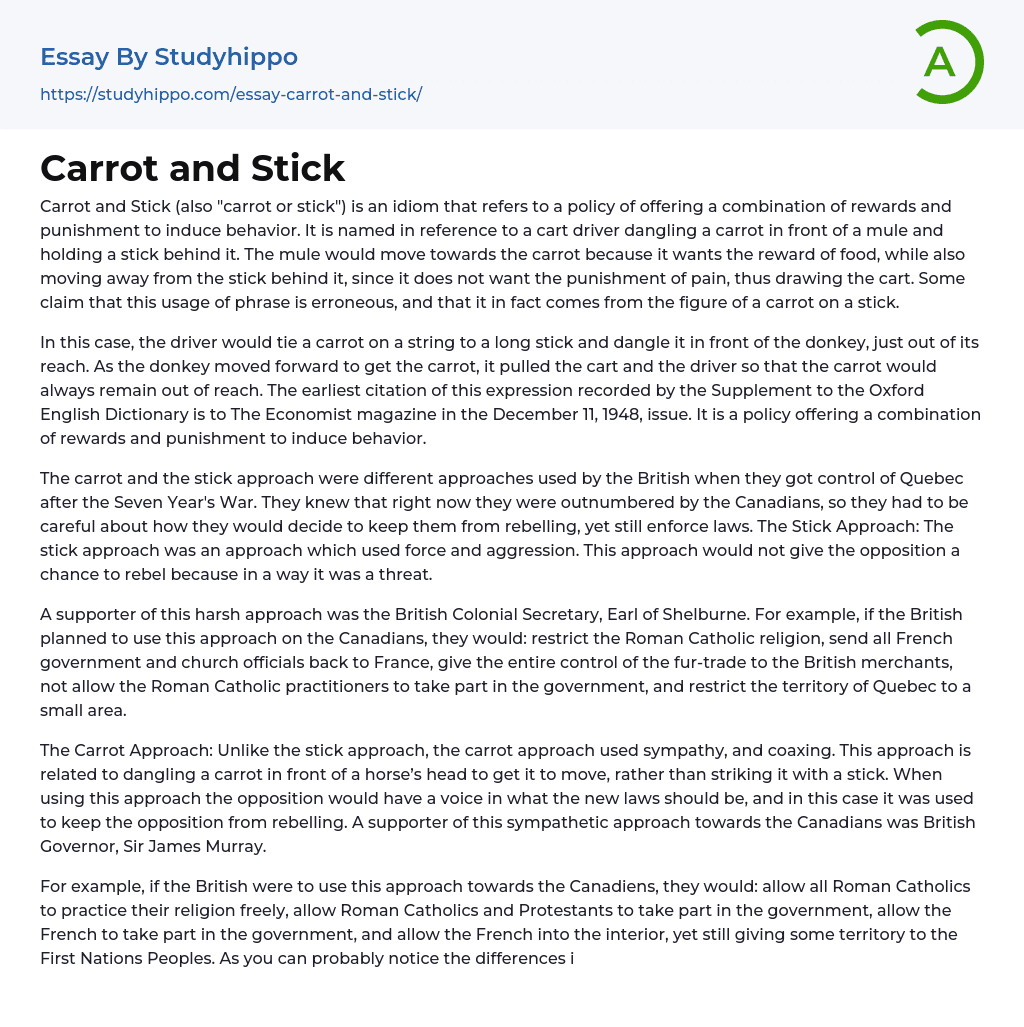Carrot and Stick (also "carrot or stick") is an idiom that refers to a policy of offering a combination of rewards and punishment to induce behavior. It is named in reference to a cart driver dangling a carrot in front of a mule and holding a stick behind it. The mule would move towards the carrot because it wants the reward of food, while also moving away from the stick behind it, since it does not want the punishment of pain, thus drawing the cart. Some claim that this usage of phrase is erroneous, and that it in fact comes from the figure of a carrot on a stick.
In this case, the driver would tie a carrot on a string to a long stick and dangle it in front of the donkey, just out of its reach. As the donkey
...moved forward to get the carrot, it pulled the cart and the driver so that the carrot would always remain out of reach. The earliest citation of this expression recorded by the Supplement to the Oxford English Dictionary is to The Economist magazine in the December 11, 1948, issue. It is a policy offering a combination of rewards and punishment to induce behavior.
The carrot and the stick approach were different approaches used by the British when they got control of Quebec after the Seven Year's War. They knew that right now they were outnumbered by the Canadians, so they had to be careful about how they would decide to keep them from rebelling, yet still enforce laws. The Stick Approach: The stick approach was an approach which used force
and aggression. This approach would not give the opposition a chance to rebel because in a way it was a threat.
A supporter of this harsh approach was the British Colonial Secretary, Earl of Shelburne. For example, if the British planned to use this approach on the Canadians, they would: restrict the Roman Catholic religion, send all French government and church officials back to France, give the entire control of the fur-trade to the British merchants, not allow the Roman Catholic practitioners to take part in the government, and restrict the territory of Quebec to a small area.
The Carrot Approach: Unlike the stick approach, the carrot approach used sympathy, and coaxing. This approach is related to dangling a carrot in front of a horse’s head to get it to move, rather than striking it with a stick. When using this approach the opposition would have a voice in what the new laws should be, and in this case it was used to keep the opposition from rebelling. A supporter of this sympathetic approach towards the Canadians was British Governor, Sir James Murray.
For example, if the British were to use this approach towards the Canadiens, they would: allow all Roman Catholics to practice their religion freely, allow Roman Catholics and Protestants to take part in the government, allow the French to take part in the government, and allow the French into the interior, yet still giving some territory to the First Nations Peoples. As you can probably notice the differences in these two approaches are huge, yet they were both used for the same reasons.
- Puritans essays
- Afterlife essays
- Buddhism essays
- Christianity essays
- Deism essays
- Faith essays
- God essays
- Hinduism essays
- Islam essays
- Jews essays
- Judaism essays
- Monotheism essays
- New Testament essays
- Ritual essays
- Sin essays
- Soul essays
- Theology essays
- Confession essays
- Devil essays
- Miracle essays
- Monk essays
- Revelation essays
- Atheism essays
- Immortality essays
- Jainism essays
- Sinners essays
- Bible essays
- Old Testament essays
- Salvation essays
- Temple essays
- Taoism essays
- Pilgrimage essays
- Freedom Of Religion essays
- Existence of God essays
- Christian Worldview essays
- Cosmological Argument essays
- Gautama Buddha essays
- Karma essays
- Buddha essays
- Baptism essays
- Holy Spirit essays
- Jesus Christ essays
- Adam And Eve essays
- Crucifixion Of Jesus essays
- Crusades essays
- Eucharist essays
- God The Father essays
- Pope essays
- Protestantism essays
- Christian essays




